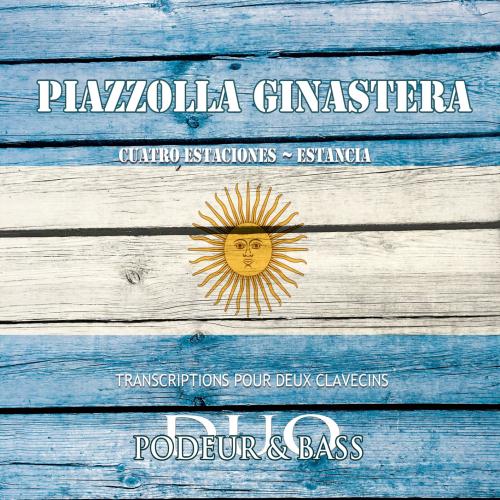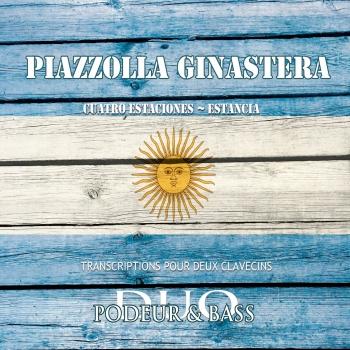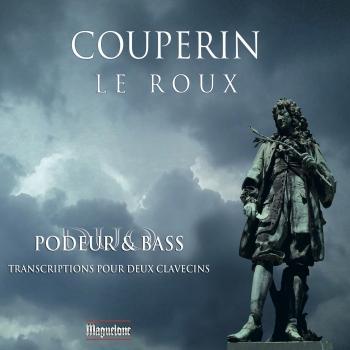
Piazzolla: Las 4 Estaciones Porteñas - Ginastera: Estancia Duo: Podeur & Bass
Album Info
Album Veröffentlichung:
2018
HRA-Veröffentlichung:
26.01.2018
Label: Maguelone Music
Genre: Classical
Subgenre: Chamber Music
Interpret: Duo: Podeur & Bass
Komponist: Astor Piazzolla (1921-1992), Alberto Ginastera (1916-1983)
Das Album enthält Albumcover Booklet (PDF)
- Ástor Piazzolla (1921 - 1992): Las 4 Estaciones Porteñas (Arr. J. Bass & M. Podeur):
- 1 Las 4 Estaciones Porteñas (Arr. J. Bass & M. Podeur): I. Invierno Porteño 07:56
- 2 Las 4 Estaciones Porteñas (Arr. J. Bass & M. Podeur): II. Primavera Porteño 05:48
- 3 Las 4 Estaciones Porteñas (Arr. J. Bass & M. Podeur): III. Verano Porteño 06:27
- 4 Las 4 Estaciones Porteñas (Arr. J. Bass & M. Podeur): IV. Otoño Porteño 06:11
- Alberto Ginastera (1916 - 1983): Estancia, Op. 8 (Arr. J. Bass & M. Podeur):
- 5 Estancia, Op. 8 (Arr. J. Bass & M. Podeur): Introducción y Escena 02:28
- 6 Estancia, Op. 8 (Arr. J. Bass & M. Podeur): Pequeña Danza 01:42
- 7 Estancia, Op. 8 (Arr. J. Bass & M. Podeur): Danza del Trigo 03:40
- 8 Estancia, Op. 8 (Arr. J. Bass & M. Podeur): Los Trabajadores Agrícolas 03:16
- 9 Estancia, Op. 8 (Arr. J. Bass & M. Podeur): Los Peones de Hacienda 02:02
- 10 Estancia, Op. 8 (Arr. J. Bass & M. Podeur): Los Puebleros 02:51
- 11 Estancia, Op. 8 (Arr. J. Bass & M. Podeur): Triste Pampeano 04:10
- 12 Estancia, Op. 8 (Arr. J. Bass & M. Podeur): La Doma 02:10
- 13 Estancia, Op. 8 (Arr. J. Bass & M. Podeur): Idilio Crepuscular 02:35
- 14 Estancia, Op. 8 (Arr. J. Bass & M. Podeur): Nocturno 04:06
- 15 Estancia, Op. 8 (Arr. J. Bass & M. Podeur): Escena 01:55
- 16 Estancia, Op. 8 (Arr. J. Bass & M. Podeur): Danza Final 04:06
Info zu Piazzolla: Las 4 Estaciones Porteñas - Ginastera: Estancia
Harpsichords at the Heart of Contemporary Music: It may raise a few eyebrows that 20th century music should be arranged for the harpsichord and worse still, for two of them. Most people associate the instrument with early music, the sound world of Renaissance and Baroque court life. Yet in the past the harpsichord was always at the forefront of avant-garde experiments in composition and acoustics.
François Couperin made innovations in fingering and sound production, Jean-Philippe Rameau explored the relations between different European styles, Domenico Scarlatti fearlessly pushed for- ward keyboard techniques developing, improvisation, ornamentation, diminutions and continuo playing. Maybe the harpsichord sound stimulates creative musical minds.
Under pressure from the piano, the instrument’s popularity waned during the Romantic period until it was almost forgotten. However, Wanda Landowska’s championing of the instrument in the early 1900s, aided by manufacturers Pleyel and Érard, sparked a wave of interest and new compositions such as Manuel de Falla’s Concerto (1923-6) and Francis Poulenc’s Concert champêtre (1927-8).
Post-1950, the repertoire burgeoned with music by Gyorgy Ligeti, Luciano Berio, Maurice Ohana, Iannis Xenakis... and today the harpsichord is well-established in contemporary music.
Preparation of the pieces for these recordings has been guided by attention to the rich harmonic palette a harpsichord can produce. Whether light and delicate or powerfully incisive, the range of sounds and rhythmical effects is vast, particularly when varying combinations of registrations on both harpsichords.
Adapting chamber or orchestral music for key- board instruments is part of a long tradition and we are certainly not the first to make harpsichord transcriptions of music by the composers featured here. Mention in particular should be made of arrangements of Piazzolla Tangos by Argentinian duo Mario Raskin and Oscar Milani.
Our own experiments have helped us juggle with the limpidity of voices, dramatic contrast, energetic repetition of notes, use of dissonance and contrapuntal relief. Popular dance music was the mainstay of Renaissance and Baroque players so the leap is not very far to these Piazzolla and Ginastera pieces which are both intended for dancers. Harpsichords, like pianos or guitars, are ideal in marking time and creating the urge to move in rhythm.
Both Piazzolla and Ginastera deploy popular dance in various ways as a bridge towards innovative modern aesthetics and the harpsichord helps clarify their musical intentions. We hope our arrangements communicate some of this creative energy to our listeners.
Mireille Podeur, harpsichord
Orlando Bass, harpsichord
Didier Henry, baritone
Mireille Podeur
studied the harpsichord, music theory and chamber music at the Paris Conservatory and then under Kenneth Gilbert at Maintenon Château and the Salzburg Mozarteum University. She also has a postgraduate degree in musicology from the University of Paris-Sorbonne. A Ministry of Culture grant enabled her to spend a year in the USA and Canada where she made a series of programmes for Radio Canada on keyboard repertoire. Returning to teach at Rouen University, she founded Arts Baroques, an ensemble which performed in numerous festivals (e.g. Sablé, Ambronnay, Dieppe, Nantes Printemps des Arts, La Chabotterie). Together with Rouen Opera Company she directed her ensemble in an award-winning recording of the opera Euridice by Jacopo Peri (Maguelone records) and was commissioned to work for three years at Rouen’s Théâtre des Arts on masterclasses in 17th century Italian opera with Howard Crook and Isabelle Poulenard. An invitation to work with Jean-Luc Impe’s Les Menus Plaisirs du Roy baroque opera company led to productions at Ambronnay, Sablé, Brussels, Paris, la Chabotterie, Versailles Orangerie and making
recordings for Arte television’s Musica series.
After teaching at Rouen University she became head of the Early Music departments at Nice Conservatory and then at Limoges Conservatory where she has developed a number of baroque operas for the students including for example Orfeo by Luigi Rossi in collaboration with choreographer Gilles Poirier, linguistic specialist Paolo Zedda and Thomas Leconte from Versailles Centre for Baroque Music.
The double harpsichord duo Podeur & Bass was formed in 2013 with Orlando Bass and so far has released a succession of baroque and contemporary works recorded on Maguelone label. These include transcriptions for two harpsichords of J. Ph. Rameau’s Pièces de clavecin en Concerts (2013), the Concerti Grossi opus 6 by Handel (2015), Four Seasons by Piazzolla and Estancia by Ginastera (2017) plus François Couperin and Gaspard Leroux (2018/19).
Orlando Bass
is a Franco-British pianist, harpsichord player, composer and accompanist. He has studied arrangement and composition (Fabien Waksman, Jean-Baptiste Courtois, Thierry Escaich, Alain Mabit), accompaniment (JeanFrédéric Neuburger, Erika Guiomar), improvisation (Jean- François Zygel) and is completing a degree in piano under Roger Muraro at the CNSMD Paris Conservatory. Currently writing a thesis on composer, painter and engraver Michel Ciry, Orlando has been championing the composer by performing his works in recitals and preparing a series of recordings. Recent awards obtained in international competitions include first prize at the Paris Festival-Competition (2016) in modern piano repertoire, first prize at Les Virtuoses du Cœur (2016) and first prize at the Paola Bernardi Harpsichord Competition in Bologna, Italy (2015).
In adition to the harpsichord duo with Mireille Podeur, transcribing and recording works for the Maguelone label, Orlando Bass has also recorded a programme of modern and contemporary Preludes & Fugues for the piano on the Indésens label.
A growing body of personal compositions and commissions so far includes mostly music for piano, chamber ensembles and solo instruments. He is also a regular improviser for projections of silent films and a much solicited player for the first performances of contemporary solo or chamber works.
Booklet für Piazzolla: Las 4 Estaciones Porteñas - Ginastera: Estancia











